AI Coaching
24 October 2024
How AI coaching works and what it does for you
Golf may not have been the very first sport that became an outlet of analysis tools using artificial intelligence (henceforth “AI”). Yet with the progress in image recognition software and modelling, it became not only possible but increasingly useful to have machines analyze and rate human movement, including even complex motions such as the golf swing.
BAL.ON as a training system was the first offer in the market to even go one step further: it includes AI-based coaching as a feature of our app. Let’s briefly explain how AI works and what AI coaching can do for you to hit better shots and have more fun in the game.
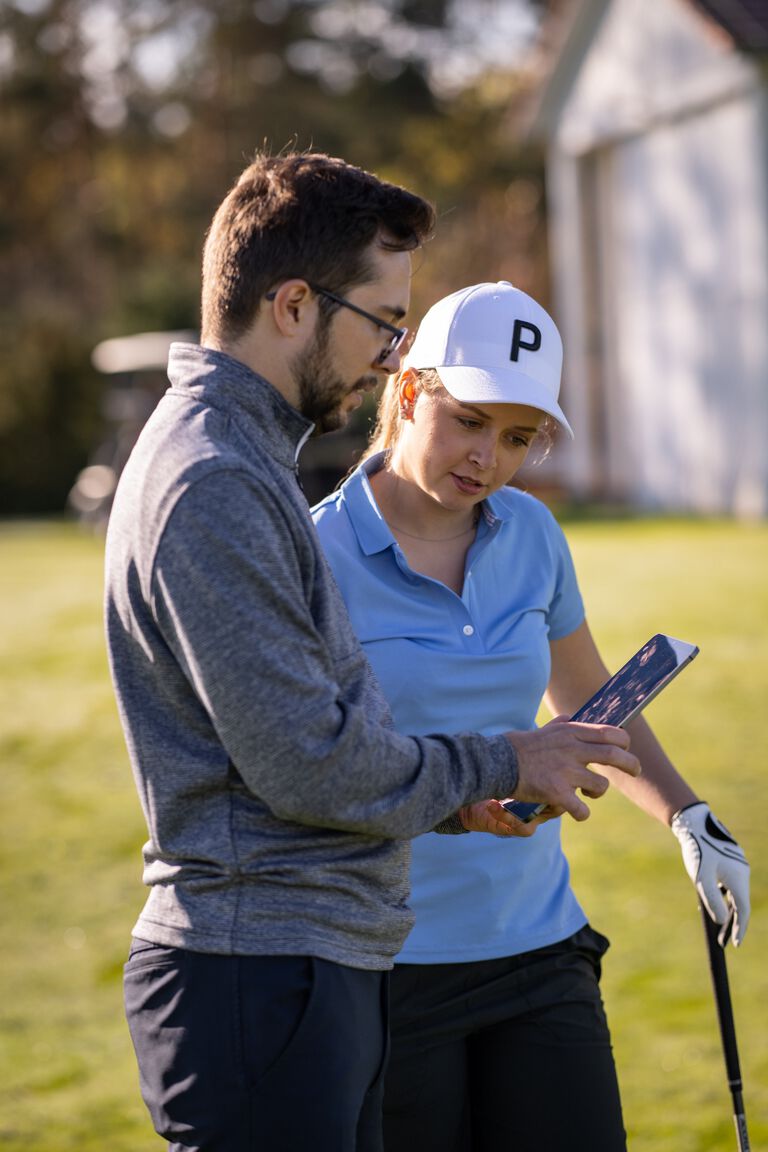
Coaches and students can check their performance regularly with BAL.ON to gain further feedback on technical details of the golf swing.
Who puts the intelligence into AI?
In order to enable a machine to rate your swing and propose anything to improve it, the machine must first know what makes a good golf swing in general. In other words, the smartness in BAL.ON’s analysis is largely rooted in the construction of criteria. At BAL.ON, we call those criteria swing metrics. Currently, our system uses seven swing metrics to rate swings. They are setup, backswing, transition timing, impact, max vertical, vertical timing, and rhythm.
Crunching numbers for shrewd advice
Metrics can be body angles, pressure patterns, timing ranges, speeds – anything that can be captured in a digital value or better yet range of values. To select them, the BAL.ON sports scientists go to great lengths parsing through thousands of detailed motion sequences, analyzing which performance characteristic can be considered ideal and why. A lot of research, with the Sports University of Madrid among others, goes into this process, and countless discussions with pros, coaches, and teams validate and substantiate it.
Whatever finally becomes a swing metric must meet two conditions: it must be a sound indicator, thus really helping pros as well as amateurs in their training as a reliable yardstick. And secondly, it must be easy to capture and process within the BAL.ON setup. For example, if the input base for a metric are video sequences, the frame rate of current mobiles, i.e. some 120 frames per second, becomes the determining factor.
Ranges over single values
To account for individual variance among golfers, we usually define brackets, not single values in our metric creation. For example, the optimum range for the setup is a pressure pattern of some 60% pressure on the lead leg (the leg facing your target) and around 40% pressure on the trail leg (the leg facing away from your target). The words “some” and “around” are key here – it’s never strictly 55% pressure, and all other values are off. In that way, BAL.ON can duly reflect individual movement characteristic and at the same time be exact and conclusive in determining whether any given player is in the ideal corridor or not.
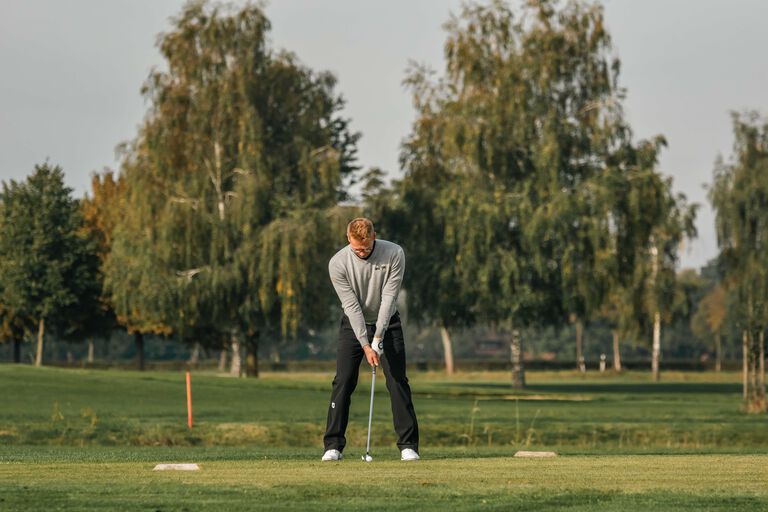
BAL.ON always goes for the ideal corridor of values instead of single, fixed values when rating swings. At setup, we consider a range of 55–60% pressure on the lead leg as ideal.
Labelling – the vocabulary exercise for machines
Another arduous phase in creating the BAL.ON smartness is qualifying the image recognition model to actually recognize something. In principle, this is not so different from the training an aspiring junior coach undergoes. It consists of learning and memorizing the visual cues within a movement sequence. Only that the machine does not learn anything by itself but receives identifying information on the data input. This process is called labelling.
To give a practical example, in the adjacent picture, we have experimented with a so-called skeleton model. Sports and data scientists at BAL.ON “teach” this model to recognize certain parts of the player’s skeleton, in this case the arms. That means, industrious hands and minds must feed the model with thousands of pictures of player skeletons, and for each label the arms as “arms” until it is able to independently detect another player’s arms in any newly filmed sequence.
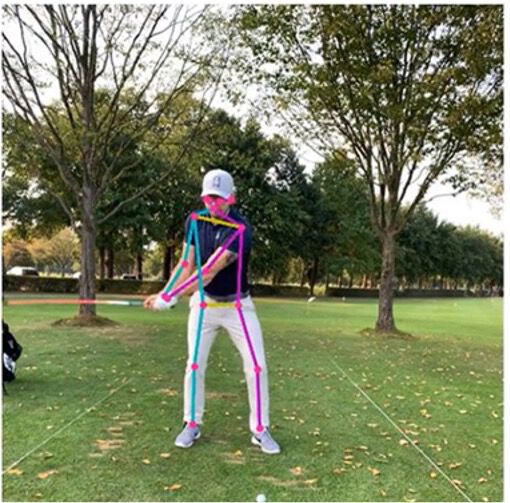
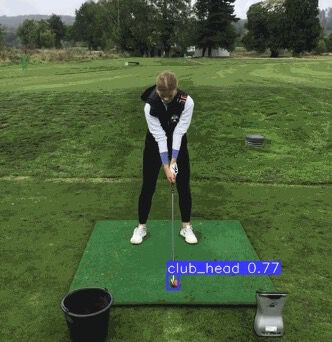
Following the same rationale, in the picture with the lady on the hitting mat, the model has been trained on spotting the clubhead.
The numbers highlighted in blue mark the degree of confidence, from 0 to 1, the model has as to whether what it frames within the bounding box is actually a clubhead.
If what the model determines as clubhead is correct, the clubhead coordinates become a basis for further calculations.
Image recognition as calculating base
We can now have the model calculate the angle between the clubhead and the player’s arm. That's a telling metric for several reasons: first off, within downswing, the closer the club shaft is to the golfer’s body, i.e. the smaller the angle, the higher the club head speed. And high club head speed means a forceful, potentially rather wide shot, which is what golfers want. Also, the club shaft angle is an indicator for the quality and consistency with which the clubhead makes contact with the ball.
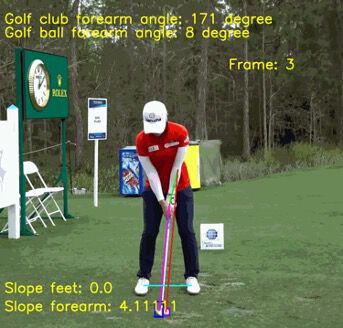
And finally, the appropriate angle especially in the impact position implies a chance to control the shot’s direction.
Teaching the model to feed back
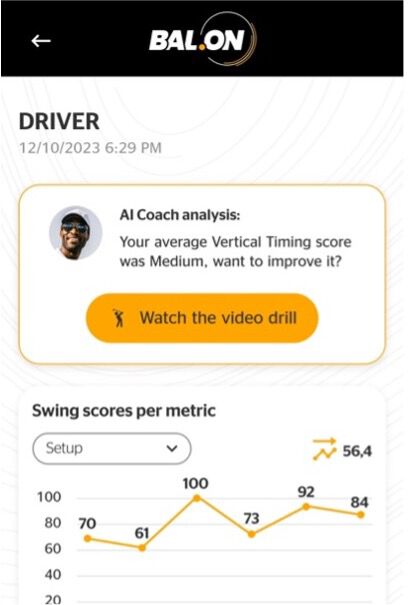
When metric definition, model feeding, labelling and training are successfully passed, the remaining step is defining a rating hierarchy. Once this is down, the model can make different recommendations, depending on how our multi-factor rating went with any given athlete.
The underlying algorithm is a little too complicated to explain here.
The important point is that AI coaching relies on a model that receives ample labelling input until it can recognize a movement independently, rate it according to the defined metrics, and dish out recommendations based on the rating hierarchy.
Why is coaching by BAL.ON beneficial?
First off, the BAL.ON Smart Kit gives you feedback instantaneously, if need be after every shot. You don’t have to schedule an appointment, you don’t have to wait for your golf coach’s availability, you don’t have to do anything other than train and watch the rating. That alone can be an important factor, especially for folks with crowded calendars.
Also, you can use the BAL.ON Smart Kit pretty much anywhere. Preferably on the range, but also on the course, with a simulator, in indoor facilities, even in your garage. The independence in time and space that you gain, in addition to the feedback, can be immensely liberating – and fun.
Work the swing from the ground up
For golfers still in their initial stage, our AI coaching offers an easy start into really foundational aspects of the game: stance, balance, shifting, timing. Sure, those are basic ingredients. Yet for a good reason, there is a saying among golf coaches, “Basics maybe easy – but the snag is, they are also easy to forget.” With BAL.ON, you get reliable advice how to heed them.
Basics are also no one-off in training. Which is why even professional golfers can still reap in the BAL.ON benefit. And it is entirely up to the individual professional what they build on top of their basic foundation.
Ideal complementing practice in general
At BAL.ON, we are quite confident about our product bonus. Yet we are also certain about its limits. After all, some of us have worked long years as coaches – we are the first to admit there is more to coaching than AI coaching. Granted, BAL.ON can “see” things forever unseen in your swing. It can feedback faster and more reliable than any human. And the system, already quite advanced, will get even better, more sophisticated, and more faceted over the years.
Yet it will never have the wisdom nor the intuition nor the wisecrack of a seasoned coach. Which are wonderful things to have. That’s why we have never been out to replace coaches – our idea is to complement the practice you are doing anyway, the solo workouts as well as the coach-guided training. Enjoy it, complement it with a dash of BAL.ON, and you will improve your swing. You will improve your game.

